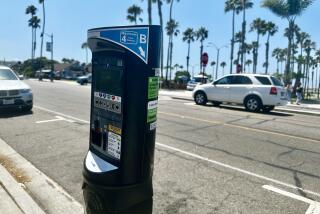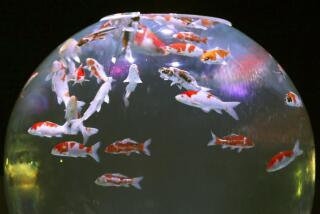Fish Will Get High-Tech I.D.s : Theft of Costly Koi Spurs Plan to Use Silicon Chips
Troubled by the disappearance of 60 expensive Japanese fish, officials at Descanso Gardens have accepted a Norco firm’s offer to implant some of the remaining koi with a silicon chip that would provide identification in case of theft.
Frank Manwarren, a Glendale resident and sales representative for American Veterinary Identification Services , said he asked his firm to donate the devices after reading about the suspected theft of the fish several weeks ago.
Acting on a tip, sheriff’s deputies traced two suspects to a Glendale home and found a koi pond there. But no charges were filed because deputies were unable to identify any of the fish as the ones missing from Descanso.
Descanso officials and Manwarren said the tagging might take place as early as next week.
Would Be a Deterrent
“This would be a good way to see if we can prevent the loss of some valuable fish,” said Francis Ching, director of the county Department of Arboreta and Botanic Gardens.
Manwarren declined to say how many of the park’s remaining 50 fish will be tagged. But he said that even a few tags should be a deterrent to thieves.
“It’s psychology. If somebody knows the fish are numbered they’re not going to steal them,” he said.
Koi-- a Japanese species of carp--are known for their bright colors and patterns. They can grow to a length of more than three feet, said Philip Ishizu, a San Gabriel koi breeder and former president of the Associated Koi Clubs of America.
Ishizu said prize specimens often fetch more than $100,000, although local koi collectors say that Descanso Gardens’s 50 fish are worth much less--from $10 to several thousand dollars each.
Black Market for Fish
Some koi dealers, like Ishizu, and victims of recent koi thefts allege that there is a black market in stolen fish. Identification is difficult, they said, because many fish look alike. But other experts, such as Robert Finnegan, an Orange County koi enthusiast and editor of a bimonthly koi magazine, dismiss the idea of a black market as fanciful.
Nevertheless, Manwarren said, he has implanted the devices in exotic birds, pedigreed dogs and a number of university laboratory animals. In addition, the Los Angeles Zoo plans to buy an unspecified number of the devices for its animals in the coming months to discourage thefts, a zoo spokeswoman said.
The procedure utilizes a glass-encased silicon chip about the size of a grain of rice and a magnetic wand that scans the chip and registers a 10-digit identification number.
Manwarren said he injects the chips into the animal’s fleshy tissue using a specialized needle and syringe. He claims that the embedded chip causes the animal no pain or discomfort and establishes ownership if the animal is stolen or turns up lost.
A spokesman for the American Veterinary Medical Assn. said that while the group does not have a formal position, it supports the idea.
No Fingerprints
Animals “don’t have fingerprints,” noted John Boyce, the association’s assistant director of scientific activities. “This is a good program but an expensive one.”
Indeed, identification does not come cheap. The wands run about $1,600 each, Manwarren said. Silicon chips are another $8.50 each. Both are available only to veterinarians, Manwarren said. Several firms now manufacture such devices, he added.
Descanso Gardens is obtaining only the silicon chips; in case of future thefts, Manwarren said he will go out and attempt to identify the fish with his own wand.
Meanwhile, Descanso’s missing koi have not turned up and Los Angeles County sheriff’s deputies say the scent has grown cold.
More to Read
Sign up for Essential California
The most important California stories and recommendations in your inbox every morning.
You may occasionally receive promotional content from the Los Angeles Times.










